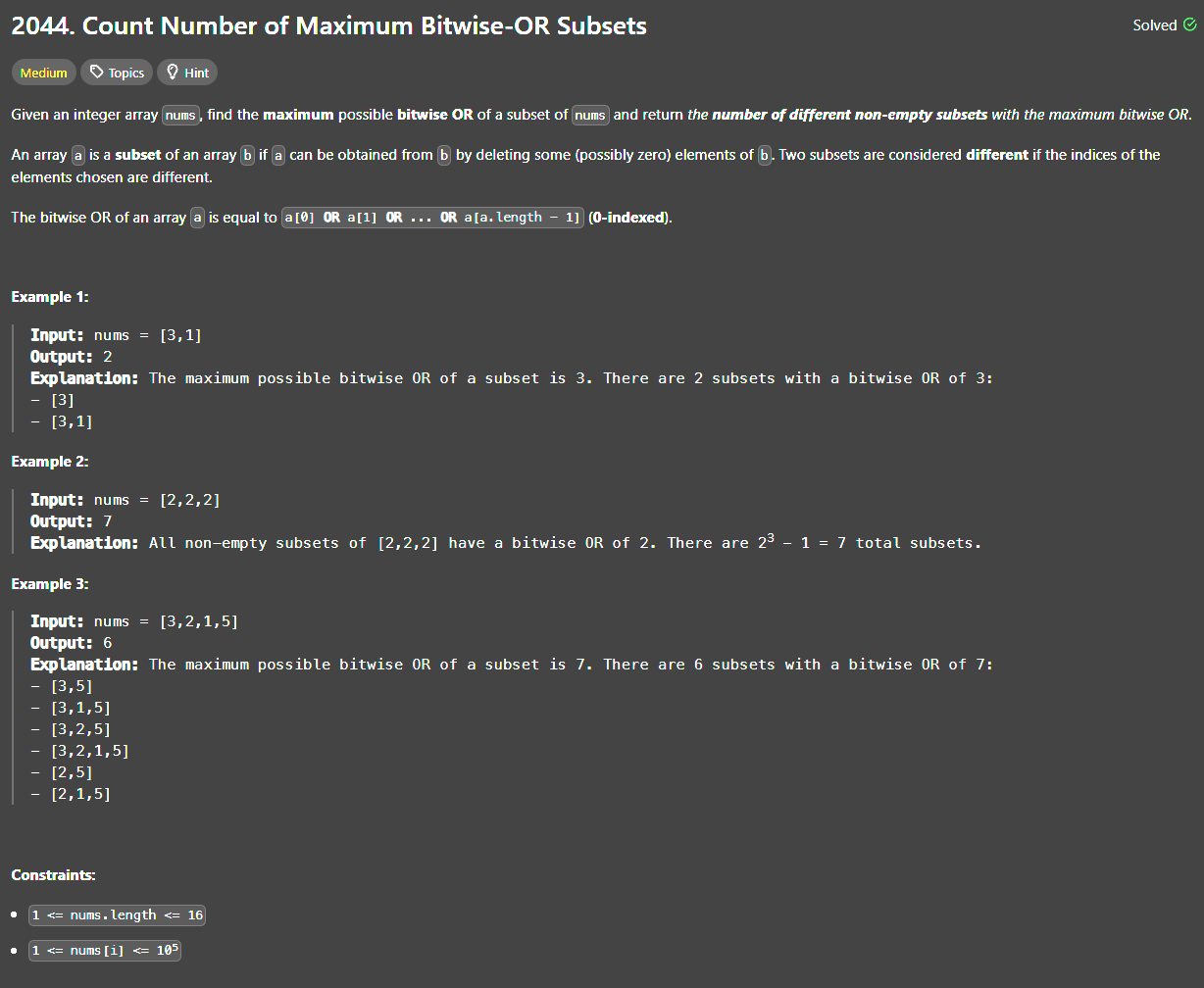Problem of The Day: Count Number of Maximum Bitwise-OR Subsets
Problem Statement

Intuition
The problem requires counting subsets of an array such that the bitwise OR of the subset equals the maximum bitwise OR possible for the entire array. The first intuition is to calculate the maximum bitwise OR for the full array and then search for all subsets that match this value.
Approach
-
Calculate Maximum Bitwise OR:
First, we calculate the maximum bitwise OR (max_bitwise_or) of the entire array. This will serve as the benchmark for the subsets. Thecalchelper function takes an array and computes the cumulative bitwise OR for its elements. -
Subset Exploration:
We use a backtracking approach to explore all possible subsets of the given array. For each subset, we compute its bitwise OR and compare it with themax_bitwise_or. If they match, we increment a result counter (res). -
Backtracking Algorithm:
The recursive functionfind_subsetsstarts from an indexiand generates all possible subsets by including or excluding the current element. At each recursive step, if the subset’s bitwise OR equalsmax_bitwise_or, we increment the counter. -
Edge Case Handling:
The algorithm handles edge cases such as an empty array or subsets that do not match the bitwise OR by simply skipping them.
Complexity
-
Time complexity:
The algorithm generates all subsets of the array, and for each subset, it calculates the bitwise OR. The total number of subsets is ( 2^n ), and for each subset, calculating the bitwise OR takes ( O(n) ) time in the worst case.
Therefore, the overall time complexity is:
\(O(n \cdot 2^n)\) -
Space complexity:
The space complexity is determined by the recursive call stack depth and the space needed for the current subset. In the worst case, the depth of recursion and the size of the current subset can be ( O(n) ), so the space complexity is:
\(O(n)\)
Code
class Solution:
def countMaxOrSubsets(self, nums: List[int]) -> int:
def calc(arr):
ret = 0
for num in arr:
ret |= num
return ret
N = len(nums)
res = 0
max_bitwise_or = calc(nums)
def find_subsets(i, curr):
nonlocal res
if i > N:
return
if calc(curr) == max_bitwise_or:
res += 1
for j in range(i, N):
curr.append(nums[j])
find_subsets(j + 1, curr)
curr.pop()
find_subsets(0, [])
return res
Editorial
Approach 1: Recursion
class Solution:
def countMaxOrSubsets(self, nums: List[int]) -> int:
max_or_value = 0
for num in nums:
max_or_value |= num
return self._count_subsets(nums, 0, 0, max_or_value)
def _count_subsets(
self, nums: List[int], index: int, current_or: int, target_or: int
) -> int:
# Base case: reached the end of the array
if index == len(nums):
return 1 if current_or == target_or else 0
# Don't include the current number
count_without = self._count_subsets(
nums, index + 1, current_or, target_or
)
# Include the current number
count_with = self._count_subsets(
nums, index + 1, current_or | nums[index], target_or
)
# Return the sum of both cases
return count_without + count_with
Approach 2: Memoization
class Solution:
def countMaxOrSubsets(self, nums: List[int]) -> int:
max_or_value = 0
n = len(nums)
# Calculate the maximum OR value
for num in nums:
max_or_value |= num
# Initialize memo with -1
memo = [[-1] * (max_or_value + 1) for _ in range(n)]
return self._count_subsets_recursive(nums, 0, 0, max_or_value, memo)
def _count_subsets_recursive(
self,
nums: List[int],
index: int,
current_or: int,
target_or: int,
memo: List[List[int]],
) -> int:
# Base case: reached the end of the array
if index == len(nums):
return 1 if current_or == target_or else 0
# Check if the result for this state is already memoized
if memo[index][current_or] != -1:
return memo[index][current_or]
# Don't include the current number
count_without = self._count_subsets_recursive(
nums, index + 1, current_or, target_or, memo
)
# Include the current number
count_with = self._count_subsets_recursive(
nums, index + 1, current_or | nums[index], target_or, memo
)
# Memoize and return the result
memo[index][current_or] = count_without + count_with
return memo[index][current_or]